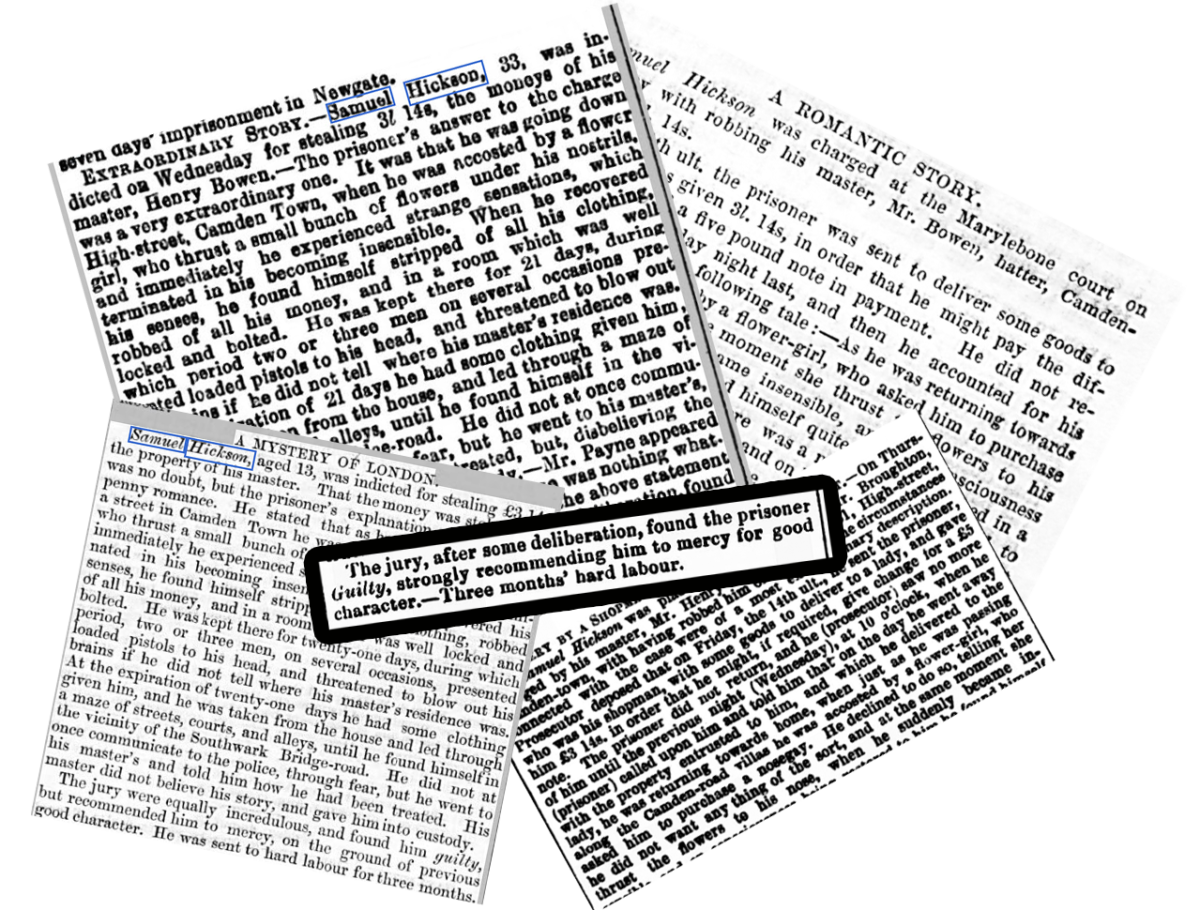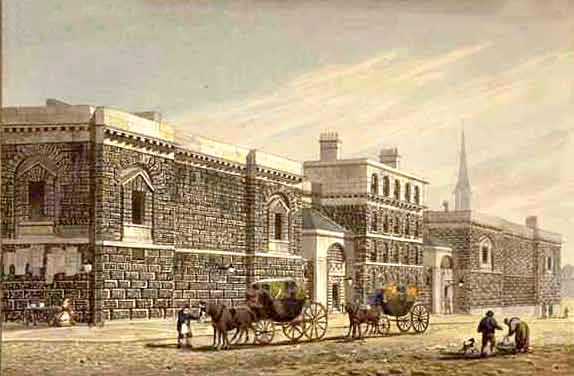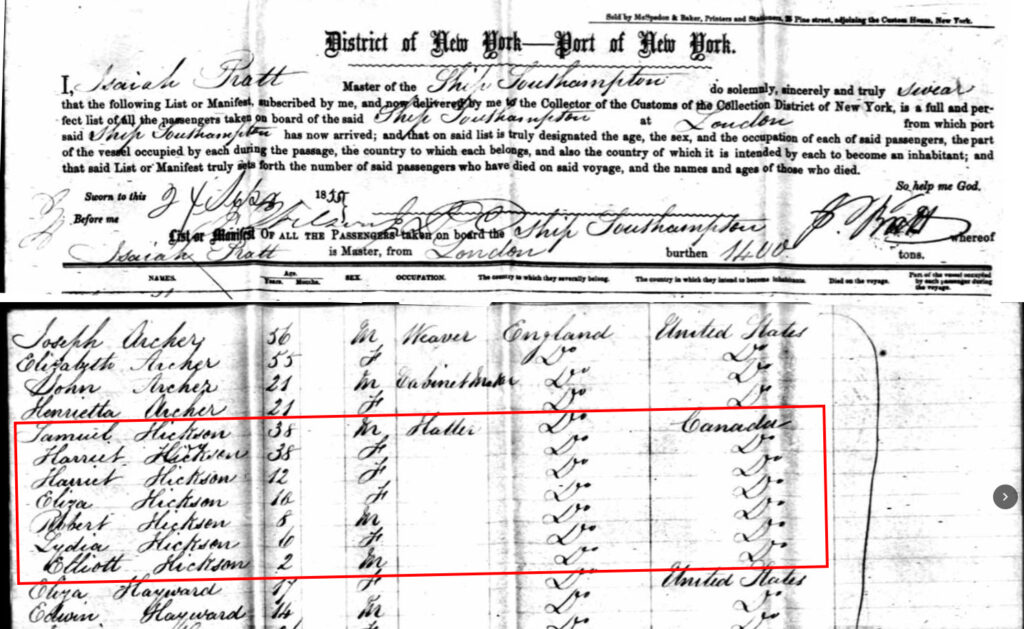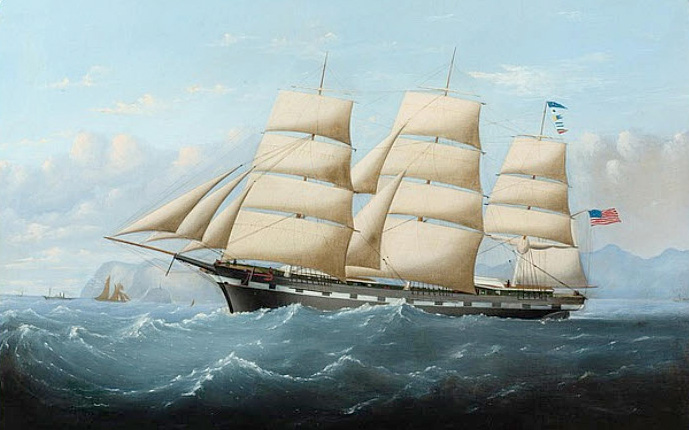
We don’t know why Samuel Richard Hickson stayed behind in England, while his mother and brother’s family sailed to Canada in May 1850. We had initially assumed that, by this time, he was established as a hatter and perhaps not as desperate to improve his circumstances. Maybe that wasn’t an accurate assumption.

In June of 1850, Samuel Richard Hickson had four children and one on the way. He was working for Mr. Henry Bowen, a master hatter with an establishment on the High Street in Camdentown. This was a diverse area originally planned as a residential community for the upperclass. The wealthy did reside in the western Regent’s Park area. But when the railway was built splitting the area in two, the town quickly welcomed the warehouses, factories, and homes of the working classes. Samuel and his family lived at #1 Cook’s Terrace, off of the Old St. Pancras Road – definitely in the working class part of town. In fact, this street was demolished in the early 1860’s to build the huge St. Pancras railway station.
So, we thought that the next step in Samuel’s life journey would be his own family’s emigration to Canada which we know happened in 1855. However, what genealogy research would be complete without a search of the local newspapers just to see if your ancestral family was mentioned. In a city the size of London, this would most likely be a fruitless endeavor, but not in this case. Samuel Richard Hickson made the news in London in the summer of 1850.
I can’t improve on the “color” included in the account in the London Morning Advertiser, so you can read for yourself. But here is a complete recap, if you’re in a hurry.
On June 14, 1850, a Friday afternoon, Samuel Hickson was sent out by his boss, Mr. Bowen, to make a delivery to a lady. Assuming that the lady would pay with a 5£ note, Mr. Bowen gave Samuel the sum of 3£ 14 pence which he would need to give the lady her change. This was on Friday, June 14, 1850. As per his account: After making the delivery, he was returning home when he was approached by a flower-girl asking him to buy a nosegay. She pushed the flower to his nostrils, and he lost consciousness. When he came to, he was naked in a bed, robbed of all his money, in a locked and bolted room in a miserable apartment. There was a man in the apartment. Samuel begged to be liberated and was told “No, we are not quite done with you.” He was kept in the room for 21 days. A woman came every day and gave him coffee and bread. During that time two or three men would occasionally come and put a pistol to his head and threaten to “blow his brains out” if he did not tell them where his master’s residence was. After 21 days, on July 4, 1850, Samuel was given some clothing and led through a maze of streets and alleys and left in a courtyard. He found himself in the vicinity of the Southwark Bridge Road. He first thought of killing himself to avoid his predicament. However, he decided to go home to his wife. The following Wednesday, 5 days past, Samuel came to Mr. Bowen at 10 p.m. and communicated his ordeal. Mr. Bowen did not believe him and turned him over to police custody and filed theft charges. (One paper stated that Samuel had stolen from Mr. Bowen before.)1 It was never clarified at the trial that if Samuel had successfully made the delivery to the lady, as he claimed, he would have had 5£ in his possession — so I’m guessing she never got her package! Why was that not mentioned?

The trial was held on the 21st of August at the Old Bailey. Mr. Payne appeared for Samuel and argued that there was no evidence whatever to say that his story wasn’t true. However, the jury, after some deliberation, found Samuel guilty, but strongly recommending him to mercy for good character. He was sentenced to three calendar months hard labor.
Samuel began his sentence on the first of September. He was incarcerated in the Newgate Prison in central London – right adjacent to the Old Bailey court where he was tried and convicted. Hopefully, he was home by the time his son was born in early 1851. Harriett’s parents had gone to Canada with his mother and certainly, she had received word that her sister, Sarah, had perished on her journey to Canada. So, it is safe to assume that Samuel’s legal troubles, loss of employment, and his absence from the home was undoubtedly a hardship on the family.

And then there’s his account of his crime. Although not impossible, It does seem quite far-fetched, and, at the end of the day, the court did not believe him. It does lead one to contemplate Samuel’s character and, perhaps, his mental health.
At the time the 1851 census was taken, Samuel had been released. He still reported himself to be a “hatter”, but it is difficult to believe that he was employed as such after his conviction. Samuel’s son Thomas Seth Elliott Hickson was born about the beginning of January 1851. On the 1851 census, taken on March 30, 1851, Thomas’ age was given as 3 months old. His birth appears in the first quarter of the 1851 birth registrations.
By 1854, the family had moved out of the St. Pancras neighborhood and to #18 Church Street, in Homerton, very near where the Mabins and Hicksons had lived before they departed for Canada. On February 8, 1854 the family registered their “settlement” at the parish governed by the Hackney Workhouse. This was necessary to qualify for assistance from the civil parish, should their situation require it. It was critical to prove that they belonged to this parish. A married man could be considered “settled” if he had stayed somewhere for 12 months, paid parish rates and rented property for over 10£ a year. The settlement papers for Samuel allowed his “settlement” by virtue of the fact that he had paid their one year rental lease of 30 £ and had “paid all rates”. So, even though we do not have an actual request for travel funds for Samuel and his family (like we did for Sarah Hickson & the Mabins), it is very plausible to assume that their travel to Canada was also financed by the Hackney Workhouse.

On the 24th of September, 1855, the American packet ship Southampton arrived in the Port of New York. On the Intermediate deck was Samuel Hickson, 38, Hatter, and his wife and five children. At least they weren’t in Steerage Lower Deck. They arrived in New York, but their final destination was Canada. They would most probably have traveled to Buffalo, NY and entered Canada there. And then it would have been 145 miles to reunite with their family in London, Ontario.


- 1It was never clarified at the trial that if Samuel had successfully made the delivery to the lady, as he claimed, he would have had 5£ in his possession — so I’m guessing she never got her package! Why was that not mentioned?
